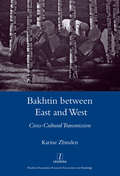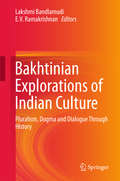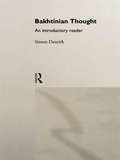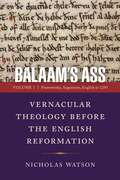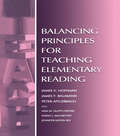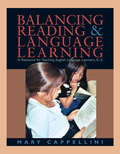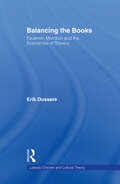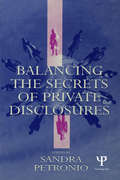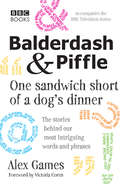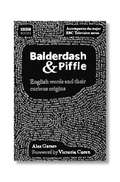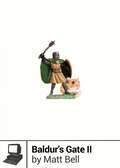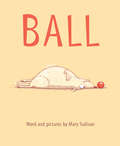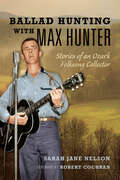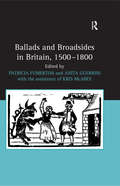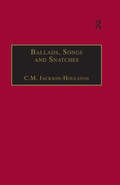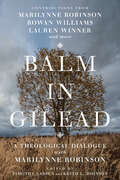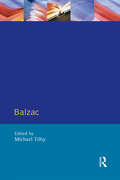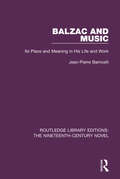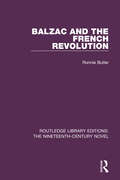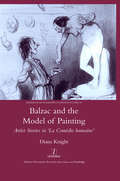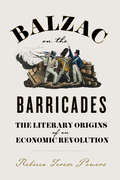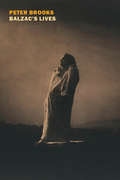- Table View
- List View
Bakhtin Between East and West: Cross-cultural Transmission
by Karine Zbinden"Mikhail Bakhtin (1895-1975) has had an enormous influence on literary studies and cultural theory. Bakhtin between East and West: Cross-Cultural Transmission looks beyond the concepts of carnival and dialogue and traces for the first time the transformation of the Bakhtin Circle's thought from its introduction to the West in Julia Kristeva's seminal late-1960s theory of intertextuality, through Tzvetan Todorov's landmark study and on to contemporary interpretations. The notion of sociality in all its problematic complexity provides the red thread guiding us through this historical and thematic examination of Western and Russian Bakhtin studies. As a critical evaluation of Bakhtin scholarship across various cultures and a celebration of the vigour of the Circle's legacy, this is an invaluable resource for scholars and students with an interest in Bakhtin and critical theory."
Bakhtinian Explorations of Indian Culture: Pluralism, Dogma and Dialogue Through History
by E. V. Ramakrishnan Lakshmi BandlamudiThis volume, an important contribution to dialogic and Bakhtin studies, shows the natural fit between Bakhtin’s ideas and the pluralistic culture of India to a global academic audience. It is premised on the fact that long before principles of dialogism took shape in the Western world, these ideas, though not labelled as such, were an integral part of intellectual histories in India. Bakhtin’s ideas and intellectual traditions of India stand under the same banner of plurality, open-endedness and diversity of languages and social speech types and, therefore, the affinity between the thinker and the culture seems natural. Rather than being a mechanical import of Bakhtin’s ideas, it is an occasion to reclaim, reactivate and reenergize inherent dialogicality in the Indian cultural, historical and philosophical histories. Bakhtin is not an incidental figure, for he offers precise analytical tools to make sense of the incredibly complex differences at every level in the cultural life of India. Indian heterodoxy lends well to a Bakhtinian reading and analysis and the papers herein attest to this. The papers range from how ideas from Indo-European philology reached Bakhtin through a circuitous route, to responses to Bakhtin’s thought on the carnival from the philosophical perspectives of Abhinavagupta, to a Bakhtinian reading of literary texts from India. The volume also includes an essay on ‘translation as dialogue’ – an issue central to multilingual cultures – and on inherent dialogicality in the long intellectual traditions in India.
Bakhtinian Thought: An Introductory Reader (Critical Readers In Theory And Practice Ser.)
by Simon DentithFirst published in 1994. Routledge is an imprint of Taylor & Francis, an informa company.
Bal Mahabharat Katha class 7 - NCERT - 23: बाल महाभारत कथा ७वीं कक्षा - एनसीईआरटी - २३
by Rashtriy Shaikshik Anusandhan Aur Prashikshan Parishadबाल महाभारत कथा चक्रवर्ती राजगोपालाचार्य की महाभारत कथा का संक्षिप्त रूप कक्षा 7 के लिए हिंदी की पूरक पाठ्यपुस्तक - महाभारत की कथा महर्षि पराशर के कीर्तिमान पुत्र वेद व्यास की देन है। व्यास जी ने महाभारत की यह कथा सबसे पहले अपने पुत्र शुकदेव को कंठस्थ कराई थी और बाद में अपने दूसरे शिष्यों को । मानव-जाति में महाभारत की कथा का प्रसार महर्षि वैशंपायन के द्वारा हुआ। वैशंपायन व्यास जी के प्रमुख शिष्य थे। ऐसा माना जाता है कि महाराजा परीक्षित के पुत्र जनमेजय ने एक बड़ा यज्ञ किया। इस महायज्ञ में सुप्रसिद्ध पौराणिक सूत जी भी मौजूद थे। सूत जी ने समस्त ऋषियों की एक सभा बुलाई। महर्षि शौनक इस सभा के अध्यक्ष हुए। एन. सी. ई. आर. टी. इस पुस्तक की रचना के लिए बनाई गई पाठ्यपुस्तक निर्माण समिति के परिश्रम के लिए कृतज्ञता व्यक्त करती है।
Bal Ram Katha class 6 - NCERT - 23: बाल राम कथा ६वीं कक्षा - एनसीईआरटी - २३
by Rashtriy Shaikshik Anusandhan Aur Prashikshan Parishadबाल राम कथा के अध्यायों में भगवान राम के जीवन में घटित सभी महत्वपूर्ण घटनाओं का विवरण दिया गया है, जिसमें उनके वन निष्कासन से लेकर रावण के साथ युद्ध और अयोध्या में उनके राज्याभिषेक तक शामिल हैं। छात्र इन महत्वपूर्ण प्रश्नों से भगवान राम के बारे में बहुत सारी जानकारी प्राप्त कर सकते हैं। प्रश्न और उत्तर उन्हें अध्यायों की गहरी और अधिक विस्तृत समझ प्रदान करते हैं। वे प्रश्नों का अभ्यास कर सकते हैं और अपनी तैयारी की रणनीति को बढ़ावा दे सकते हैं। चूंकि बाल राम कथा पुस्तक में 12 अध्याय हैं, इसलिए छात्रों के लिए सभी अध्यायों पर समान ध्यान देना महत्वपूर्ण है। वेदांतु के महत्वपूर्ण प्रश्न छात्रों को पूरी किताब को बार-बार पढ़े बिना अभ्यास करने की अनुमति देकर मदद करते हैं। वे अपनी अंतिम परीक्षाओं में आमतौर पर पूछे जाने वाले कुछ प्रश्नों का पता लगाने के लिए प्रश्नों का अध्ययन भी कर सकते हैं। जब परीक्षा में अच्छे अंक प्राप्त करने की बात आती है तो यह कुछ ऐसा है जो उन्हें बहुत मदद करेगा।
Balaam's Ass: Volume 1: Frameworks, Arguments, English to 1250 (The Middle Ages Series)
by Nicholas WatsonFor over seven hundred years, bodies of writing in vernacular languages served an indispensable role in the religious and intellectual culture of medieval Christian England, yet the character and extent of their importance have been insufficiently recognized. A longstanding identification of medieval western European Christianity with the Latin language and a lack of awareness about the sheer variety and quantity of vernacular religious writing from the English Middle Ages have hampered our understanding of the period, exercising a tenacious hold on much scholarship.Bringing together work across a range of disciplines, including literary study, Christian theology, social history, and the history of institutions, Balaam's Ass attempts the first comprehensive overview of religious writing in early England's three most important vernacular languages, Old English, Insular French, and Middle English, between the ninth and sixteenth centuries. Nicholas Watson argues not only that these texts comprise the oldest continuous tradition of European vernacular writing, but that they are essential to our understanding of how Christianity shaped and informed the lives of individuals, communities, and polities in the Middle Ages.This first of three volumes lays out the long post-Reformation history of the false claim that the medieval Catholic Church was hostile to the vernacular. It analyzes the complicated idea of the vernacular, a medieval innovation instantiated in a huge body of surviving vernacular religious texts. Finally, it focuses on the first, long generation of these writings, in Old English and early Middle English.
Balancing Principles for Teaching Elementary Reading
by Peter Afflerbach James V. Hoffman James F. Baumann Sarah J. McCarthey Ann M. Duffy-HesterThis book appears at a time when the crisis rhetoric about schools, teaching, and learning to read is extremely high. There is a rising call within the profession for a balanced perspective on reading. Balancing Principles for Teaching Elementary Reading aspires to help set the agenda for improving the quality of literacy instruction in the United States--by recentering the debate from "What's better, 'whole language' or 'phonics'?" to "What can we do in reading instruction to prepare all children for the literacy demands of the next century?" The authors, all members of the professional community of reading educators, work on a daily basis with teachers in classrooms, prospective teachers, clinicians, and tutors. Their goal for this book is to represent what they have learned about effective teaching and learning as members of this community. It is written with four purposes in mind: * to offer a principled conception of reading and learning to read that is considerate of both the personal dimensions of literacy acquisition as well as the changes that are taking place in society, * to summarize key findings from the research that relate specifically to effective teaching practices, * to describe current practices in reading instruction with specific comparisons to the principles of effective practice that are identified, and * to suggest an action agenda that is school-based and designed to promote positive changes in the quality of instruction. This text offers a perspective for teaching that provokes members of the reading education community to think about their underlying beliefs about teaching and their shared commitment to making schools more effective for the students they serve. It is envisioned as a resource to be used in building a community of learners--to be read with professional colleagues in a course of study, in a teacher-researcher book club, or in some type of in-service setting. Readers are encouraged to debate the ideas presented, to challenge the authors' conceptions with their own reality, to make sense within a community about what action is desirable. Some specific suggestions and strategies are provided as springboards for further exploration and action.
Balancing Reading and Language Learning: A Resource for Teaching English Language Learners, K-5
by Mary CappelliniTeaching reading to children in a language that is not their own is a daunting task. Balancing Reading and Language Learning: A Resource for Teaching English Language Learners, K-5 provides the strategies proven to be effective in a balanced reading program, while at the same time valuing the native culture and first-language skills of the English language learner. Combining the best classroom practices and research on teaching reading and language acquisition, author Mary Cappellini integrates effective reading instruction with effective language instruction. Through the framework of a balanced reading program, she emphasizes the importance of constantly listening for and assessing children's language and reading strategies during read aloud, shared reading, guided reading, and independent reading, including literature circles.Included in this text are: How to set up an environment that will allow all English language learners to succeed Stages of English language proficiency and stages of reading development—how they compare and how to use them to assess and plan for individual children A focus on tapping into children's prior knowledge in their primary language while teaching reading in English and using Spanish/English cognates to help develop academic language A collection of in-depth lessons and mini-lessons based on children's language proficiency and reading strategy needs with ongoing assessment, teacher reflection, and with an emphasis on choosing the right books to match their reading and language level How to manage numerous guided reading groups with children of all stages of reading and language proficiency Thematic planning, with sample units for primary and upper grades, to support academic language and meet content standards Ideas for literacy evenings, school tours, and other events to involve parents with the learning community Extensive resources: numerous forms and checklists—observation sheets, planning sheets, literature response sheets, focus sheets for shared and guided reading, and more. Regardless of how many or how few ELL students a teacher has, this invaluable resource helps them meet the challenges and reap the rewards of teaching children to read as they learn the language.
Balancing the Books: Faulkner, Morrison and the Economies of Slavery (Literary Criticism and Cultural Theory)
by Erik DussereBalancing the Books represents a sophisticated examination of the ongoing engagement of American literature with the economies of slavery through the works of William Faulkner and Toni Morrison. Both Faulkner and Morrison write about the relationship between race, identity, and history, and about how the legacies of slavery linger in the lives and actions of their characters, although the narrative strategies through which they render these themes ultimately diverge. Dussere brings considerations of debt and repayment, exchange and accounting, and capital and the market-concepts inseparable from any consideration of race in the construction of the American nation-into dialogue with the work of Faulkner and Morrison to produce an outstanding work of literary and cultural criticism.
Balancing the Secrets of Private Disclosures (Routledge Communication Series)
by Sandra PetronioThis book joins together disclosure, privacy, and secrecy to pursue a greater understanding of how people are both public and private in their interactions. To be social yet autonomous, known yet unknown, independent yet dependent on others is essential to the communicative world. How do people manage these seemingly incongruous goals? This book argues that they actively work at balancing simultaneous needs of being both public and private. It highlights many different ways that people balance their public needs with their privacy needs underscoring the multidimensional nature of balance. The chapters also show that the opposing needs occur within a variety of contexts, from health issues, such as HIV/AIDS, to television talk shows. Readers will discover that avoiding disclosure is a dominant theme. In this way, the authors demonstrate how people balance privacy and secrecy by deemphasizing openness. Taken as a whole, this volume offers a refreshing new look at age-old concerns.
Balderdash & Piffle: One Sandwich Short of a Dog's Dinner
by Alex GamesBalderdash & Piffle: One Sandwich Short of a Dog's Dinner is a thrilling ride through the provocative, bewildering and often downright bizarre world of language and etymology. From the brash jargon of celebrity magazines to the delicacies and feints of the euphemism, author and word-sleuth Alex Games has uncovered the remarkable stories that lie behind some of our best-loved words and expressions. By grouping words into distinct themes - such as put downs and insults, the vocab of fashionistas and the lingo of dodgy dealings - Balderdash & Piffle looks at the English language in a fresh and revealing light. Who was the original Jack the Lad? What is the tragic story behind the expression Sweet F.A.? Balderdash & Piffle will show you where thugs come from, why 'barmy' once had more to do with your beer than your brain, and how a little bit of 'hanky-panky' could literally work magic. From the 'Cloud-cuckoo-land' of Aristophanes to the town of Balaclava, this is a funny but rigorously researched account of English words and their origins. Drawing together sources as diverse as William Shakespeare, David Cameron and the Burnham-on-Sea Gazette, Alex Games recalls the trends, innovations and scandals that have produced some of our most familiar but least explored words and phrases. Accompanying a brand new series of the hit BBC television programme Balderdash & Piffle - and containing all the results of the 'Wordhunt' from the first series -this entertaining book is a treasure trove for English-language lovers everywhere.
Balderdash & Piffle: The Complete Balderdash And Piffle Collection Of English Words, And Their Curious Origins
by Alex GamesDiscover the fascinating stories behind the words and phrases we use every day. English is now the worlds most popular second language, understood by over 700 million people across the globe. Its use is amazingly broad: not only is it the language of Chaucer and Shakespeare, but also of hip-hop, international business and the internet (over 80% of home pages are in English). So where exactly do English words come from? They come from everywhere. English is a vast, rambling conglomeration of words and phrases from a huge variety of times and places, and every word has its own intriguing history. Balderdash & Piffle is a guidebook an entertaining look at what falls out of the chaotic family tree of English words when you uproot it and give it a damn good shake. Shaking the tree is writer, humourist and word-sleuth Alex Games. If youve ever wondered who first used cuppa in print, what language gave us shampoo, when we started saying window, where minging comes from, what Shakespeare had to say about geeks and why berk is really, really rude, youll find it all (and much more) inside. Youll also have the chance to do your own word-sleuthing, through the BBC Wordhunt appeal. Who knows if you have written evidence of a bouncy castle from before 1986, you could even re-write history
Baldur's Gate II (Boss Fight Books)
by Matt BellUpon its release in 2000, BioWare's PC role-playing epic Baldur's Gate II: Shadows of Amn was hailed as a paragon of its genre and named RPG of the Year by IGN, GameSpy, and GameSpot. A game like Baldur's Gate II requires not just a master wordsmith but a dungeon master. Enter award-winning novelist Matt Bell, author of four works of fiction and co-author of the Dungeons & Dragons novel The Last Garrison. Bell's book explores BG2's immersive narrative and complex mechanics, unpacks how RPG systems enable our emotional investment in characters, investigates the game's non-linear story, and relates his own struggle to reconcile being a serious adult with his love of D&D and video games. Dig in, geek out, and go for the eyes, Boo!
Ball
by Mary SullivanA dog with a ball is one of the most relentlessly hopeful creatures on Earth. After his best little-girl pal leaves for school, this dog hits up yoga mom, baby, and even the angry cat for a quick throw. No luck. Forced to go solo, the dog begins a hilarious one-sided game of fetch until naptime's wild, ball-centric dream sequence. The pictures speak a thousand words in this comic book-style ode to canine monomania. Ball? Ball.<P><P> Winner of the Theodore Seuss Geisel Honor
Ballad Hunting with Max Hunter: Stories of an Ozark Folksong Collector (Music in American Life)
by Sarah NelsonA traveling salesman with little formal education, Max Hunter gravitated to song catching and ballad hunting while on business trips in the Ozarks. Hunter recorded nearly 1600 traditional songs by more than 200 singers from the mid-1950s through the mid-1970s, all the while focused on preserving the music in its unaltered form. Sarah Jane Nelson chronicles Hunter’s song collecting adventures alongside portraits of the singers and mentors he met along the way. The guitar-strumming Hunter picked up the recording habit to expand his repertoire but almost immediately embraced the role of song preservationist. Being a local allowed Hunter to merge his native Ozark earthiness with sharp observational skills to connect--often more than once--with his singers. Hunter’s own ability to be present added to that sense of connection. Despite his painstaking approach, ballad collecting was also a source of pleasure for Hunter. Ultimately, his dedication to capturing Ozarks song culture in its natural state brought Hunter into contact with people like Vance Randolph, Mary Parler, and non-academic folklorists who shared his values.
Ballads and Broadsides in Britain, 1500-1800
by Anita Guerrini Patricia Fumerton Kris McAbeeBringing together diverse scholars to represent the full historical breadth of the early modern period, and a wide range of disciplines (literature, women's studies, folklore, ethnomusicology, art history, media studies, the history of science, and history), Ballads and Broadsides in Britain, 1500-1800 offers an unprecedented perspective on the development and cultural practice of popular print in early modern Britain. Fifteen essays explore major issues raised by the broadside genre in the early modern period: the different methods by which contemporaries of the sixteenth through nineteenth centuries collected and "appreciated" such early modern popular forms; the preoccupation in the early modern period with news and especially monsters; the concomitant fascination with and representation of crime and the criminal subject; the technology and formal features of early modern broadside print together with its bearing on gender, class, and authority/authorship; and, finally, the nationalizing and internationalizing of popular culture through crossings against (and sometimes with) cultural Others in ballads and broadsides of the time.
Ballads, Songs and Snatches: The Appropriation of Folk Song and Popular Culture in British 19th-Century Realist Prose (The Nineteenth Century Series)
by C.M. Jackson-HoulstonAs a book on allusion, this has interest for both the traditional literary or cultural historian and for the modern student of textuality and readership positions. It focuses on allusion to folksong, and, more tangentially, to popular culture, areas which have so far been slighted by literary critics. In the nineteenth century many authors attempted to mediate the culture(s) of the working classes for the enjoyment of their predominantly middle-class audiences. In so doing they took songs out of their original social and musical contexts and employed a variety of strategies which - consciously or unconsciously - romanticised, falsified or denigrated what the novels or stories claimed to represent. In addition, some writers who were well-informed about the cultures they described used allusion to song as a covert system of reference to topics such as sexuality and the criticism of class and gender relations which it was difficult to discuss directly.
Balm in Gilead: A Theological Dialogue with Marilynne Robinson (Wheaton Theology Conference Series)
by Marilynne Robinson Timothy Larsen Rowan Williams Timothy George Lauren F. Winner Keith L. Johnson Han-luen Kantzer Komline Patricia Andujo Tiffany Eberle KrinerPulitzer Prize–winning novelist Marilynne Robinson is one of the most eminent public intellectuals in America today. In addition to literary elegance, her trilogy of novels (Gilead, Home, and Lila) and her collections of essays offer probing meditations on the Christian faith. Many of these reflections are grounded in her belief that the sixteenth-century Protestant Reformer John Calvin still deserves a hearing in the twenty-first century. This volume, based on the 2018 Wheaton Theology Conference, brings together the thoughts of leading theologians, historians, literary scholars, and church leaders who engaged in theological dialogue with Robinson's published work—and with the author herself.
Balzac (Modern Literatures In Perspective)
by Michael TilbyThis canon of French literature, Honore de Balzac (1799-1850) is also a major European figure in the development of realism. His work is dominated by an inter-related sequence of novels and short stories, La Comedie Humanine, which charts the idiosyncrasies of French society from the beginning of the nineteenth century to the 1840's. Among the most famous of these are Le Pierre Goriot and La Cousine Bette. Iin this study, Dr Tilby concentrates on the main approaches in practice and discusses some of the earliest responses to Balzac's work. His introduction and headnotes set Balzac's work in context. This book will be of interest to students of French language and literature and also to those studying French in combined studies or humanities courses.
Balzac and Music: Its Place and Meaning in His Life and Work (Routledge Library Editions: The Nineteenth-Century Novel #1)
by Jean-Pierre BarricelliFirst published in 1990, this book was the first comprehensive study of Balzac’s relationship to music, blending past scholarship with new perspectives to formulate an inclusive account. It begins by examining the contacts and experiences that shaped the musical side of Balzac’s life. These left valuable and lasting impressions which often found their way into his writings, where he recorded a myriad of critical and musicological opinions — assessed primarily in relation to Gambara and Massimilla Doni. These discussions prepare the way for an analysis of Balzac two major musical persuasions: religious music and Beethoven. This book will be of interest to students of literature and music.
Balzac and the French Revolution (Routledge Library Editions: The Nineteenth-century Novel Ser. #5)
by Ronnie ButlerFirst published in 1983. Balzac’s novels are one of the largest and most important sources for the history of post-revolutionary France, but they have scarcely been tapped as they should be. Approaching the subject from the perspective of a literary, the author shows in detail how specific historical circumstances and movement are reflected in t
Balzac and the Model of Painting: Artist Stories in La Comedie Humaine
by Diana Knight"Texts about paintings, painters and sculptors are obvious test cases for issues of representation. A significant corpus of artist stories is scattered through Honore de Balzac's Comedie humaine which, from Marx to Lukacs to Roland Barthes's enormously influential S/Z (1970), has been a key literary work for critical debates around French realism. In a series of close readings, Diana Knight explores Barthes's 'model of painting' - the metaphorical code of painting and sculpture that underpins realist discourse - in the context of Balzac's fictional representations of the relation between artists, their models and their works of art. Whereas critics have tended to denounce Balzac's realist aesthetic as complicit with the misogyny of the society he portrays,Balzac and the Model of Painting takes the artist-model relationship, variously gendered in these stories, as the focus of the author's powerful realist critique of the sexual politics of prostitution and marriage in nineteenth-century France."
Balzac on the Barricades: The Literary Origins of an Economic Revolution
by Rebecca Terese PowersThe role of nineteenth-century French literature in a distinctively modern political movement When Parisian workers took to the streets in February 1848, they adopted the rallying cry of droit au travail (the right to work). That protesters increasingly framed employment as a political right represented a radical and modern development. But where had this idea originated? In her examination of this cause célèbre of France&’s Second Republic, Rebecca Powers shows that the redefinition of labor as a basic right sprang not only from political debates but also directly from contemporary literature. Powers charts the rise of this revolutionary concept through the tales of bourgeois dominance in the novels and newspaper articles of Honoré de Balzac. As Powers explains, this realist semiotician of French provincial and urban life par excellence was the first to attempt a definition of modern labor as an integral part of the emerging modern society. Powers makes clear how recognizing Balzac&’s influence on mid-nineteenth-century political discourse is essential to understanding the course of events in that earth-shaking year.
Balzac's Lives
by Peter BrooksEnter the mind of French literary giant Honoré de Balzac through a study of nine of his greatest characters and the novels they inhabit. Balzac's Lives illuminates the writer's life, era, and work in a completely original way.Balzac, more than anyone, invented the nineteenth-century novel, and Oscar Wilde went so far as to say that Balzac had invented the nineteenth century. But it was above all through the wonderful, unforgettable, extravagant characters that Balzac dreamed up and made flesh—entrepreneurs, bankers, inventors, industrialists, poets, artists, bohemians of both sexes, journalists, aristocrats, politicians, prostitutes—that he brought to life the dynamic forces of an era that ushered in our own. Peter Brooks&’s Balzac&’s Lives is a vivid and searching portrait of a great novelist as revealed through the fictional lives he imagined.
